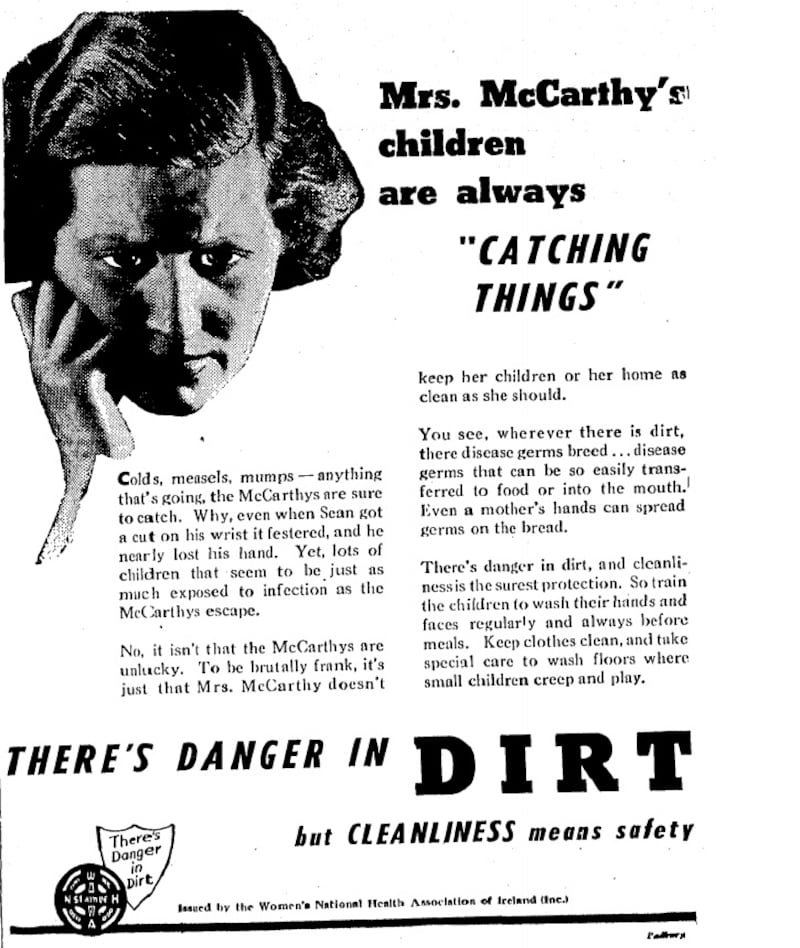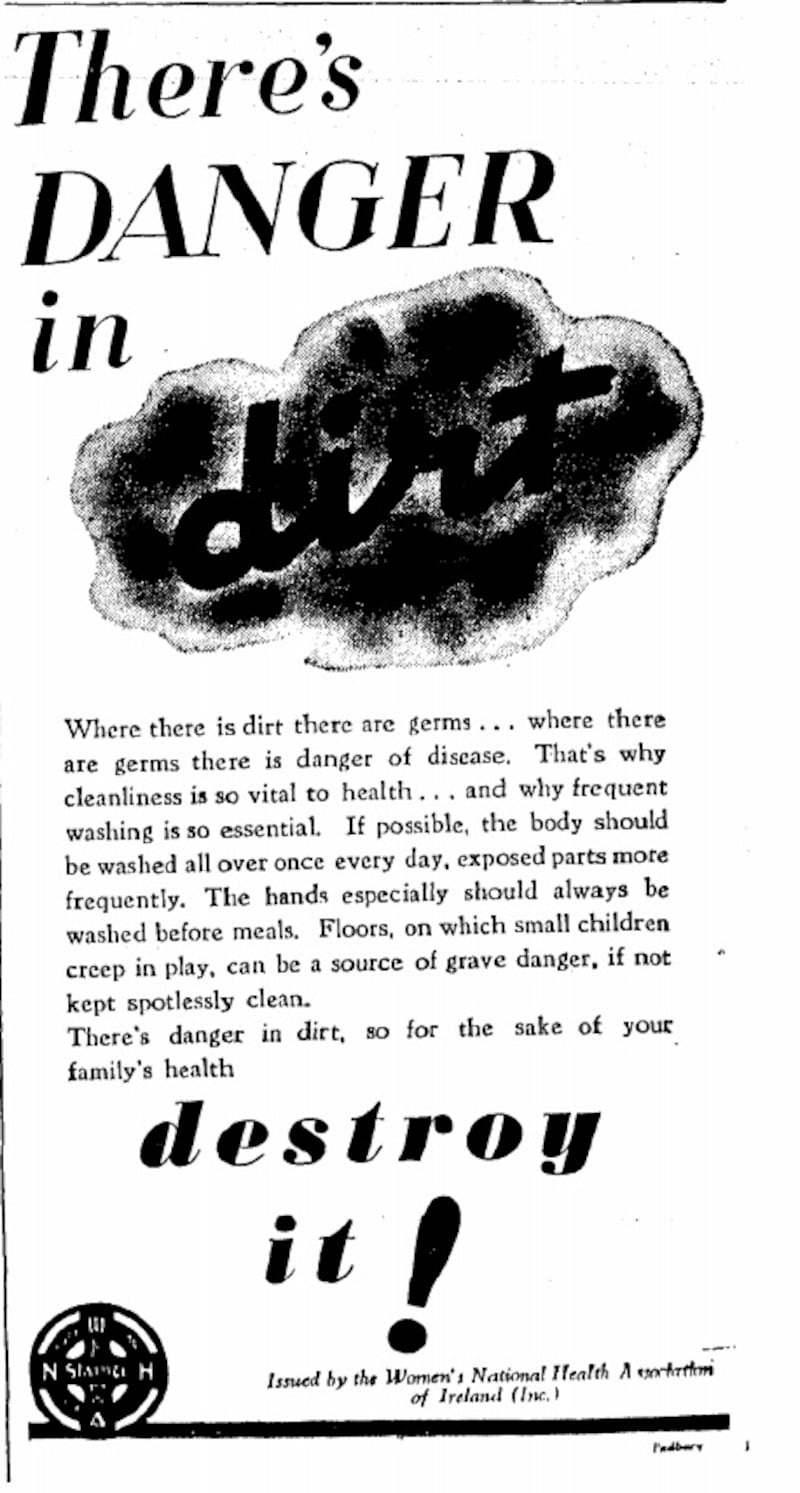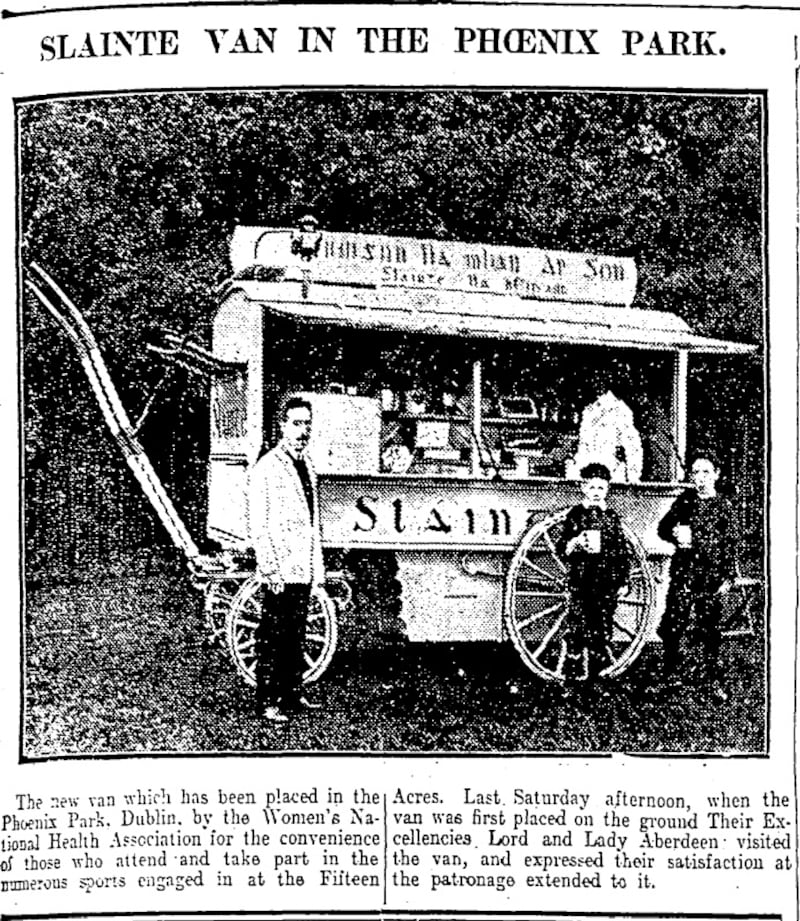“There’s Danger In Dirt” exclaimed the advertisements of the 1950s, admonishing “Mrs McCarthy” and “Mrs O’Brien” for failing to keep their children and homes clean.
The campaign was the work of the Women’s National Health Association (WNHA), who had waged war against unhygienic households since 1907.
When heat and plagues of houseflies contributed to an epidemic of diarrhoeal diseases among Dublin infants in July, 1911 – 130 deaths in three weeks – it was the WNHA who dispatched trained nurses to the homes of the poor, to teach “the elements of hygiene, and how to manage sick children”.
Though much of its pioneering – if sometimes patronising – philanthropic work has been long forgotten, the WNHA was the precursor of many of the State’s existing health systems, organisations, and charities.

The proposal to form the association appeared in the newspaper of February 11th, 1907. One of its founders, and president, was Lady Ishbel Maria Gordon – Lady Aberdeen – wife of the King's Viceroy in Ireland, though it aimed to unite women of all classes and creeds, to improve public health and "guard against disease".
Its first two “Health Problems for Consideration” were consumption – “16 out of every 100 deaths” – and infantile mortality. Also on their agenda was “the hygiene of primary schools”.
Their proposed methods included: lectures; health talks with working mothers; the appointment of women health visitors and sanitary inspectors; the urging of sanitary questions on the attention of local authorities; the distribution of simple health leaflets; and the appointment of district nurses.
As members were enlisted and branches founded around the country – 155 by 1910 – The Society News column regularly recorded The Countess of Aberdeen’s arrival at a new location.
The WNHA's touring Tuberculosis Exhibition was first held at Dublin's Herbert Park in 1907: "As indicated by maps . . . the Unions of Cork and North and South Dublin stand out prominently among the districts which suffer to the greatest extent from its ravages. The Unions of Lisnaskea in Fermanagh and Tulla in Clare appear on the other hand to suffer least."
Also on show were displays of sleeping huts and appliances used in sanatoriums: “A novel feature of this interesting collection is the turf spittoon suitable for use in country cottages. It consists of a turf sod hollowed out in the centre to receive the sputum of the patient, and after use the sod is intended to be immediately used with other turf for fuel.”
The association also sent “Éire”, its “tuberculosis caravan” to disseminate information in districts without “suitable accommodation for holding public meetings”.
Free lectures in 1908 included: Air and Ventilation; Mother and Infant; and Home Nursing. Some were targeted specifically at working class families, and even women in prison.

At one lecture, The Choice of a House, Surgeon Lentaigne said he was convinced the new association would do much good throughout the country: “But they should first . . . see that their houses were healthy, and that their servants and dependents were living under proper conditions. Let them first set their own house in order, and they could efficiently help others to do the same.”
Dr RB McVittie lecturing on The Health of the Child showed “Diagrams representing the diurnal tide of energy” and claimed “all growing children should rest in a recumbent position for at least an hour between 12 and 1 o’clock daily.”
More beneficial to children's health that year, however, was the opening of the WNHA's first pasteurised milk depot in Dublin's Arbour Hill, funded by New York philanthropist, Mr Nathan Strauss "in order to help them in their campaign against the ravages of tuberculosis and infant mortality." By 1919 free pasteurised milk was distributed to "necessitous families" from depots in Limerick, Newry, Listowel, Clonmel and Bray.
Keeping goats
Concerns about the need for a safe and plentiful source of milk for children prompted another offshoot of the WNHA in 1912; The Irish Goat Society. This encouraged the keeping of goats to supply milk to children and invalids, free from the tubercle bacillus. Its secretary even answered queries in this publication’s long-running Goat-Keeping column.
As its work to combat tuberculosis continued branches provided nurses to care for consumptive patients in their localities. According to one 1908 report, separate beds and bedding were also provided for patients, and food for their families. One Dublin nurse reported in 1913 that 1,650 visits had been made and 71 rooms disinfected.
In 1910 the association opened the Allan Ryan Hospital for Consumption on Dublin's Pigeon House Road. The preceding year Lady Aberdeen had begun negotiations with the admiralty to take over disused coastguard stations for their TB work. However, plans for the station at Sutton met opposition, even from its own local branch who claimed that: "Its use for tuberculous cases will constitute a grave danger to the health of the whole neighbourhood . . . and prevent the many holiday excursions of children to the Sutton strand." It did eventually open, but as a "Preventorium", with the promise not to take consumptive patients.
The rumour that Dalkey's station might be used as a Health Home prompted warnings of "irreparable injury to the township as a summer resort". One objection was "the suitability of the place, on account of its close proximity to the very best part of Dalkey. The rateable value of the houses within a radius of a thousand yards from the station was about a couple of thousand pounds. All these house were inhabited by the best class of people, and the rent ran up to £200 a year."

The construction of a national sanatorium at Peamount in County Dublin also raised local hackles. Protests culminated one Sunday afternoon in June 1912, when a group of 50 men armed with pickaxes and hammers demolished new pavilions, despite warning rifle shots being fired by the construction foreman. The sanatorium did open, however, and an article in 1913 maintained that WNHA efforts had saved 2,242 lives from tuberculosis in five years.
Less contentious were the association’s Babies’ Clubs, which began to appear nationwide. Trained maternity nurses were employed, and doctors provided medical checks “in addition to weighing the children, advising their mothers, providing virol, milk, food, and other help, there are classes in Hygiene and Domestic Economy, coal funds, boot clubs , etc.”
By 1915, the babies and children of “soldiers and sailors’ wives” were among those being cared for, and Mrs W Hewat, honorary secretary to Dublin’s Blackrock Club, outlined their object: “ . . . when our young men are dying in thousands, it is alarming to find that this always heavy death-rate among those who should in time fill their places, has sprung up from 150 per 1,000 to 180 per 1,000 of infants dying in their first year . . . slain through ignorance, poverty and carelessness.
“Of these three causes, ignorance is probably the greatest. The duty for which she was created is apt to be the one for which a woman receives the least training, and the popular idea seems to be that any fool can bring up a baby in the light of nature. To combat that idea, to turn ignorance to knowledge, and carelessness to watchfulness, is the object of a Babies’ Club . . .
“Poverty, and consequent lack of pure milk, drunkenness, often to grief and anxiety, too much money and too much leisure, the ‘whatever’s going’ diet, all those things are against the baby, and all those drawbacks may be counteracted to some extent by the club.”
War work undertaken by the association included: “Distress Workrooms, Clothing and Comforts Depot, Classes for First Aid and Emergency Nursing.” The conflict also prompted its Women Patrols. An article in August 1915 explained: “These ladies patrol in couples – one a Catholic, the other a Protestant, and each is provided with an armlet, a little guide book, and a card signed by the Chief Commissioner of Police . . . The work is quite different from Rescue Work, the desire of the Association being, through kindness and sympathy, to be a help to young and innocent girls, who run a danger of losing their heads through high spirits, and the excitement that is caused by the war and the number of young soldiers on the highways also seeking amusement.”
A member of the Women’s Patrol wrote to “The Editor” that October, describing the locality of Sackville Street as “one great low saloon” and recounting how she had “stood aghast at the scenes my night walks have shown me . . . more times than I can count have I turned my flashlight on to dark doorways and corners in laneways and disclosed scenes that are indescribable.”
‘Miserable homes’
“CM” continued: “Experience teaches us that girls take to the streets for many causes, and surely one of the chief reasons is the miserable tenement house, where whole families live in one room, and there can be little attempt at any decency – let alone comfort or cleanliness. Factory girls that I know do not care to go to their miserable homes till bedtime; so they frequent the streets, where mischief is just waiting for them.”
The opening of a supervised playground in 1912 on St Augustine Street was the first in “a scheme to remove the children of the poor from the dangers of the city streets”. Our correspondent wrote: “It contains an ample space . . . a sand pit, where infants may amuse themselves free from harm, a convenient shower-bath . . . and a number of cradles in which babies may enjoy the air in comfort and safety. Every day a trained nurse will attend to watch over children who are under the age for school. After three o’clock school children will be admitted.”
A report on association playgrounds in 1917 noted: “ . . . the city flitters and tatters gather in their little multitudes. Here, instead of playing in their squalid homes or in the bye-ways they have organised games. Folk dancing, toy-making, sewing and elementary lessons in gardening are taught. The Playgrounds are a moral and physical necessity . . . The wayward and the neglected children of the poor find here a little oasis in their desert lives, and the good effects often transform them into new beings.”
The association regularly went to bat for the poor’s recreational needs. Its AGM in 1919 was told that poor children had been cut off from the “natural playground” of Merrion Strands because they could get no trains to carry them. The railway company claimed this was due to “the shortage of coal”, but a Mrs Manning noted “at the same time they were running three or four extra trains for race meetings . . . The company had simply cut off the third class fares, and also made restrictions on Sundays.”
A further deputation to the railway company was agreed, and Mrs Manning also asked the association to seek the opening of the city’s Merrion and Mountjoy Squares to the public is summertime “when the residents in the square were away at the seaside”. The association’s own Fresh Air Fund would later send children away on holidays – 1,500 in 1935 alone.

There was plenty of fresh air at the Ormond Market Boys Camp, opened as part of the WNHA’s scheme to utilise derelict sites “for the benefit of the poor”. According to a pictorial spread in 1912, homeless boys were provided with alfresco “ bed, supper and breakfast” for threepence, and a hot bath for a penny. Books, boxing, and other pursuits were also on offer.
Even when she left Ireland, Lady Aberdeen continued as association president until her death in 1939.
However, her philanthropy was not always welcomed. In 1916, in response to her efforts to raise 50,000 dollars in the United States "to help save Irish babies from starvation", this paper opined: "It is really a serious thing that busy-bodies – even titled busy-bodies – should be allowed to hold Ireland up to the world as not merely a Niobe, but a slut, among the nations. There is much wretchedness in the slums of our large cities, but not nearly enough to justify this offensive patronage."
The association, however, continued its charitable work which also included: communal kitchens, school dental clinics, advisory committees on legislation, health exhibitions, meals for school children, and juvenile rheumatism clinics.
As Mrs Fegan Redmond told its 1920 AGM: “It should be known that they were raising money to do national health work that the Government ought to be doing.”









